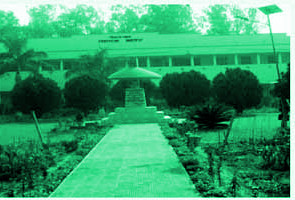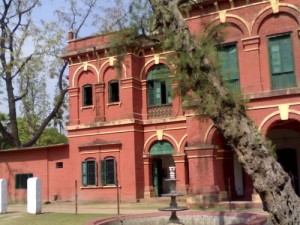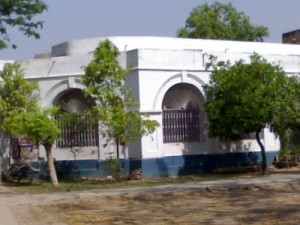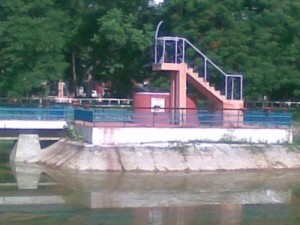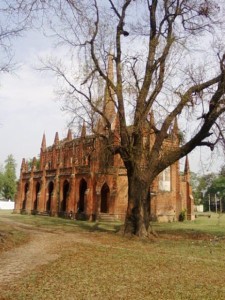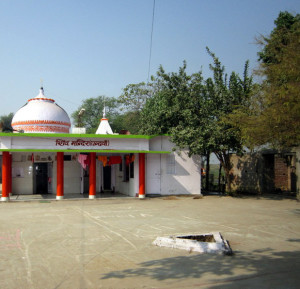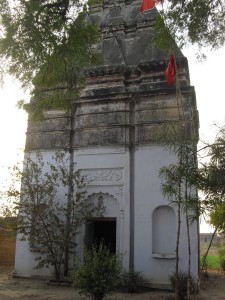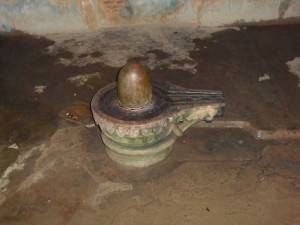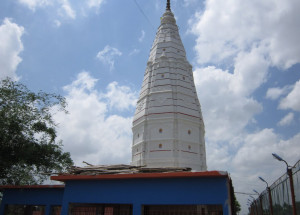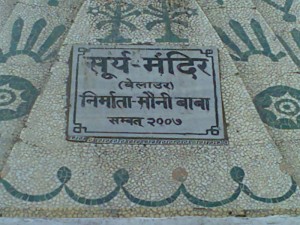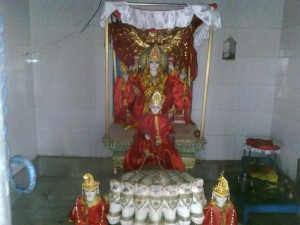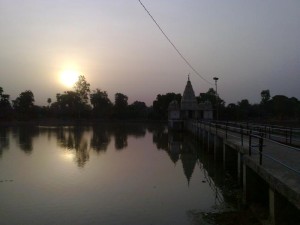ARRAH(BHOJPUR) DISTRICT
Bhojpur district is one of the thirty-eight districts of Bihar state The present district of Bhojpur came into existence in 1992. Earlier this district was the part of the Shahabad district. In the year 1972 Shahabad district was bifurcated in two parts namely Bhojpur and Rohtas. Buxar was a sub-division of old Bhojpur district. In 1992 Buxar became a separate district and rest of Bhojpur district with three sub-divisions-Ara Sadar, Jagdishpur and Piro. The 1961 Census report also describes the early period of the old Shahabad district which includes the present district of Bhojpur as :
“In the old days, Shahabad formed part of the ancient kingdom of Magadh which also contained portions of the present Patna & Gaya district. Though included in the kingdom of Emperor Ashoka, the general absence of Buddhists’ monuments from a greater part of the district suggests that it remained almost immune from the Buddhist influence of the time.”
“The famous Chinese pilgrim, Hieun-Tsang, who journeyed through the country in the seventh century A.D., paid a visit to Mo-Ho-Solo in Shahabad. This place has been identified with the present village Masarh, 10 k.m. west of Ara on Ara-Buxar road. The Chinese pilgrim found that the inhabitants were all Brahmins who did not respect the law of Buddha. He, therefore, felt disappointed and did not proceed to any other place in the district.”
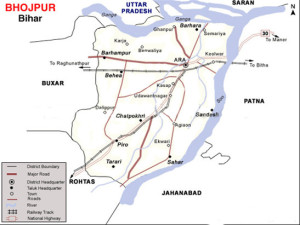 The Medieval period history of this district has been described in the following words : “While encamping at Ara in 1529 after his victory over the Afghan rulers, Babar proclaimed his sovereignty over Bihar . In commemoration of this event, the place was called Shahabad, which literally means ‘the city of Emperor’. This name was later applied to the Sarkar within which Ara was included and eventually toe entire district.” Akbar, after his accession, includes the district of Shahabad in his empire, though the control was not very tight. Akbar’s General Man Singh, made efforts to organize the revenue administration of the district on a sound footing. But the local chiefs continued to resist. The Rajas of Jagdishpur and Bhojpur defied the Mughals. The Raja of Bhojpur rebelled against Jahangir. His successor Raja Pratap, was done to death by Shahjahan and the Queen was forced to many a muslim courtier. This finally quietened the Bhojpur family but stray troubles continued till the last days of Mughals.
The Medieval period history of this district has been described in the following words : “While encamping at Ara in 1529 after his victory over the Afghan rulers, Babar proclaimed his sovereignty over Bihar . In commemoration of this event, the place was called Shahabad, which literally means ‘the city of Emperor’. This name was later applied to the Sarkar within which Ara was included and eventually toe entire district.” Akbar, after his accession, includes the district of Shahabad in his empire, though the control was not very tight. Akbar’s General Man Singh, made efforts to organize the revenue administration of the district on a sound footing. But the local chiefs continued to resist. The Rajas of Jagdishpur and Bhojpur defied the Mughals. The Raja of Bhojpur rebelled against Jahangir. His successor Raja Pratap, was done to death by Shahjahan and the Queen was forced to many a muslim courtier. This finally quietened the Bhojpur family but stray troubles continued till the last days of Mughals.
After this the District had a very uneventful history till 1857 when Kunwar Singh revolted against the Britishers in line with the Mutineers.
How To Reach
By Air(Airport) :-
Jaiprakash Narayan Airport, Patna is an airport located 58 kilometres from Arrah.
By Rail:-
The Arrah Junction (ARA) railway station, is well connected to most of the major cities in India by the railway network, which lies in between Howrah -Delhi Main Line of East Central Railway in Danapur Division, which serves it with numerous number of trains, with Railway Station as Koelwar,Kulharia,Karisath, Behea
By Road :-
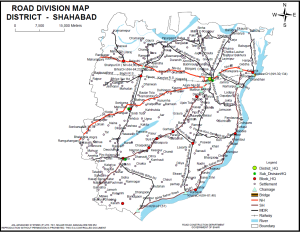 NH30, 84 SH-12,81,84 other roads- Arrah- Sinha Rd,Sandesh Sahar Rd,Arrah -Ekauna Khaira- Sahar Rd, Bihiya Jagdishpur Piro Rd, Arrah- Salempur Rd , Bihta Sahar Rd Bihiya – Tier Rd,Chandi- Sandesh Rd,Piro-Sikarhatta Bihta Rd,Bihiya – Salempur road, Koilwar- Babura Rd, Ara Akhgaon Rd,Arrah -Barhra-Ekauna Rd, Piro-Agiaon Rd, Pawna-Kori-Sandesh Rd, Koilwar Chandi Ara Rd.
NH30, 84 SH-12,81,84 other roads- Arrah- Sinha Rd,Sandesh Sahar Rd,Arrah -Ekauna Khaira- Sahar Rd, Bihiya Jagdishpur Piro Rd, Arrah- Salempur Rd , Bihta Sahar Rd Bihiya – Tier Rd,Chandi- Sandesh Rd,Piro-Sikarhatta Bihta Rd,Bihiya – Salempur road, Koilwar- Babura Rd, Ara Akhgaon Rd,Arrah -Barhra-Ekauna Rd, Piro-Agiaon Rd, Pawna-Kori-Sandesh Rd, Koilwar Chandi Ara Rd.
Arrah is located 53 kilometres West from Patna.
Popular tourist destinations
ARRAH BLOCK
The Aranyan Devi Temple :-It is situated in the Chawk area of Arrah, which is about 3.2 Km from the Arrah railway station.The Goddess Aranayn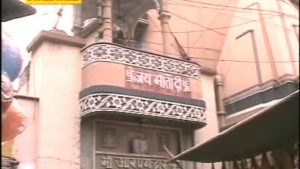 Devi is the Goddess of Sakama-Bhakti. She is supposed to fulfill whatever desires are expressed before her by the devotee. This tample is rebuilt on modern lines white mosaic and marble decorations.Two Aranya Devis one in 3 ft and other in 2 ft in height are seen standing on a throne of about 10 ft in height. One statue is of ADI SHAKTI and the second is established by the PANDAVA’s.
Devi is the Goddess of Sakama-Bhakti. She is supposed to fulfill whatever desires are expressed before her by the devotee. This tample is rebuilt on modern lines white mosaic and marble decorations.Two Aranya Devis one in 3 ft and other in 2 ft in height are seen standing on a throne of about 10 ft in height. One statue is of ADI SHAKTI and the second is established by the PANDAVA’s.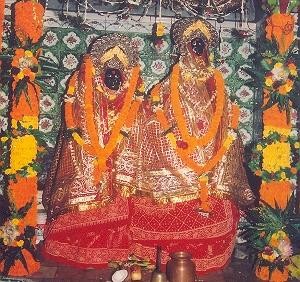 It is said that both are sisters. They are attired in yellow sari with flower garlands and mukuts on their heads. The mukuts are made of paper.The statues of the Devi’s are caved out of black stone.Like most of the temples, these temples too have a number of other status of God, Lord Krishna and Radha, Lord Rama, Bharata, Lakshmana,Shaturghna and Sita to the left side of the Devi.The local businessmen in 1953 A.D installed these. All these statues are made of white marble.
It is said that both are sisters. They are attired in yellow sari with flower garlands and mukuts on their heads. The mukuts are made of paper.The statues of the Devi’s are caved out of black stone.Like most of the temples, these temples too have a number of other status of God, Lord Krishna and Radha, Lord Rama, Bharata, Lakshmana,Shaturghna and Sita to the left side of the Devi.The local businessmen in 1953 A.D installed these. All these statues are made of white marble.
The following are the legends of this temple: –
Once Lord Krishna disguised as a hermit and Arjuna as a lion went to King Mordhwaj at Arrah, who was renowned for his generosity. The hermit demanded human flesh for his lion saying that the lion did not eat animal flesh. The hermit (Lord Krishna) asked for the flesh of the king’s son. The king was puzzled and asked for the consent of his wife. His wife agreed. The hermit asked them to dissect the body of the boy with an arra (saw). This was done jointly by the king and the queen. The hermit demanded that they cook the flesh. The king and the queen obeyed him at once. Now they were asked to eat the cooked flesh together with the hermit and the lion. This was also obeyed. The hermit asked the king to call the boy and take of the meal. The kind said that the boy was killed and cooked. The hermit said, ‘No call the boy”. The king called out the name of the boy. To their sheer amazement and joy, the boy appeared before them in a playful manner. Then Lord Krishna and Arjun gave their real identity and threw away the arra (saw) which was used in dissecting the body of the boy. The temple is said to have been erected by King Mordhwaj at the place where the saw fell.
The second legend regarding the temple is as follows: –
Like Harishchandra, King Mordhwaj was also a great benefactor and charitable – minded. He was a very kind-hearted man -noble, gentle, loving, faithful, honest and simple. His name and fame spread all over India. The fort of King Mordhwaj was a very big and spacious one covering the present Chowdhariana Mohalla, Jain school area and Devi Asthan sector. But in spite of so much prosperity and gaiety, the king and the queen were not, happy at all because they had no son. And so with intense devotion they began praying to the goddess Durga to bless them with a soil. Finally the divine blessing did dawn upon them. The goddess appeared before the king in his dream and gave her blessing, and nine months after a son was born. The royal boy was a prodigy and provided all the earthly pleasures to his parents. And so the years rolled away. One night King Mordhwaj saw in his dream goddess Durga asking him to sacrifice his son before her altar. The king took the dream seriously, conveyed it to his royal consort and both agreed to execute the mandate. And the royal prince also did not demur and was happy about the fulfillment of the divine wish. So the trial came.The king and queen applied the saw (arra) on the head of the prince and, just as they were starting to ply the saw., the divine mother appeared physically before the scene of sacrifice, blessed the couple and the prince for their devotion to her and disappeared in the blue.It was in this way that the place, which was the scene of the sacrifice, came to be known as ARRAH, meaning, a saw. It is also believed that the king installed a temple at Arrah, which was called Aranya Devi temple.
The third mythological version is that the area was covered with forest and the Ganga River was flowing near by and the people built a temple there, which was called 1he temple of Aranya Devi, i.e., goddess of the forest.
Bisram (Jain Temple) :-
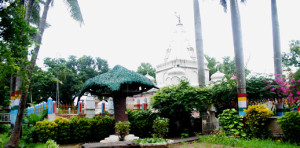 It is said that Lord Mahavira, the 24th Jain Tirthankara, took rest for some time at this place during his wanderings, hence this place is called Bisram . The Jains from every part of the country visit this place throughout the year. The Jain temple here contains an idol of Lord Mahavira. In Arrah there are another 45 Jain temples.
It is said that Lord Mahavira, the 24th Jain Tirthankara, took rest for some time at this place during his wanderings, hence this place is called Bisram . The Jains from every part of the country visit this place throughout the year. The Jain temple here contains an idol of Lord Mahavira. In Arrah there are another 45 Jain temples.
Jain Sidhant Bhawan :- It has a such library which contains unique collection of materials related to Jainism.Famous scholar of Indian Oriental Languages, late Prof. (Dr.) Nemi Chandra Shastri had contributed a lot to evolve this library into a research institute. He also edited research journal, which had an international recognition.
Art Gallery of Jaina Siddhanta Bhawan, Ara:-This Art Gallery established by Shri Ajay Kumar Jain in the memory of late Shri Nirmal Kumar Jain and Chakreshwar Kumar Jain, is situated in the premises of Shree Nath Temple Beside the Jaina Siddhanta Bhawan, Jail Road, Arrah. Many of the objects in the Gallery were brought from the local Jaina Siddhanta Bhawan and a few of them were collected from private individuals. The collection of objects in the Gallery includes ancient coins, Palm-leaf and other manuscripts, other documents and letters, stone images and pictures.
Veer Kunwar Singh University :-
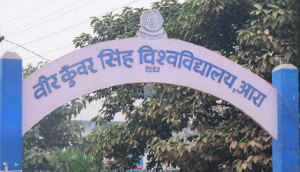 Ve
Ve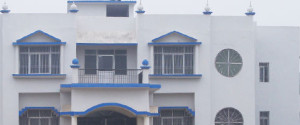 er Kunwar Singh University named after the well known national hero and distinguished freedom fighter of 1857 was established on 22nd october 1992 October, 1992 with its Headquarter at Ara, under the Bihar University Act 1976 [as amendment Act 9 of 1992]. This University has already been enlisted in the list of recognised Universities under Section 2(f) of the U.G.C. Act.
er Kunwar Singh University named after the well known national hero and distinguished freedom fighter of 1857 was established on 22nd october 1992 October, 1992 with its Headquarter at Ara, under the Bihar University Act 1976 [as amendment Act 9 of 1992]. This University has already been enlisted in the list of recognised Universities under Section 2(f) of the U.G.C. Act.
Maharaja College:-
In the. year 1954, His Excellency Maharaja Bahadur Sri Kamal Singh Jee of Dumraon Raj established a Degree college at Ara in the memory of his grandfather Maharaja Bahadur Ram Ran Vijay Singh Jee under the name of Maharaja Bahadur Ram Ran Vijay Prasad Singh college, popularly known as Maharaja college. The present Maharaja college premises is an important historical site.
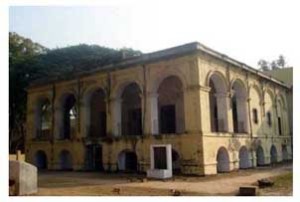 There is an entry point of a tunnel that is believed to be connected with the Jagdishpur fort of Kunwar Singh.
There is an entry point of a tunnel that is believed to be connected with the Jagdishpur fort of Kunwar Singh.
Ara House :-
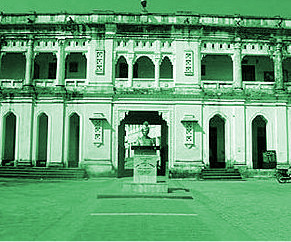 It is located within the premises of the Maharaja College. It is small double-storied building on a raised plinth built during british rule by Vicars Boyle, an Engineer of the Eastern Railway before 1857. Ara house covering a total plinth area of 51 sqft, consists of a billiard room with a small room, a bathroom attached on one side and a verandah in front with semi- circular arched colonnade. The ara house became famous in 1857 when insurrection broke out and a number of British officers took their refuge within this building from 27th July to the 3rd August 1857, till they were rescued by the British soldiers. It was held by twelve Englishmen and fifty Sikhs for over a week in opposition to two thousand sepoys from Danapur Cantonment and a large body of local nationalist. The stoical British resistance stirred the imaginations and hearts of many contemporaries and secured a unique place in British military history.(Late Medieval period)
It is located within the premises of the Maharaja College. It is small double-storied building on a raised plinth built during british rule by Vicars Boyle, an Engineer of the Eastern Railway before 1857. Ara house covering a total plinth area of 51 sqft, consists of a billiard room with a small room, a bathroom attached on one side and a verandah in front with semi- circular arched colonnade. The ara house became famous in 1857 when insurrection broke out and a number of British officers took their refuge within this building from 27th July to the 3rd August 1857, till they were rescued by the British soldiers. It was held by twelve Englishmen and fifty Sikhs for over a week in opposition to two thousand sepoys from Danapur Cantonment and a large body of local nationalist. The stoical British resistance stirred the imaginations and hearts of many contemporaries and secured a unique place in British military history.(Late Medieval period)
Sone Circle WRD Arrah Office :-
Ara Club:-
Shahi Masjid( 25°34’2″N 84°40’23″E):-This five Gumbad mosque, the second of its kind in India was constructed by Shahjahan in 1623 AD. This is situated near Aranya Devi temple.
Mosque of Maula Bagh(Karbala):-This mosque was built around 1817 with Aurangzeb’s assistance. It is situated at Maula Bagh mohalla at Ara.
Badi Masjid(Ara):-
Catholic Church(Katira):-
St Joseph Church(Pakri)
In the church there are two memorials to the Sepoy Mutiny. One can look for the one which commemorates Captain the Hon. Edward Plantagenet Robinhood Hastings.
A memorial :-Towards the east of the Treasury and Ramna Road is a memorial built to honour the officers, noncommissioned officers and men of HM 35th Regiment who laid down their lives in the Shahabad district on the 23rd of April 1858.
Jora Temple(M.P.Bag):- During Archaeological Exploration done by KP Jayaswal Research Institute Early Medieval Period site have been brought to notice. Dhanupara :- During Archaeological Exploration done by KP Jayaswal Research Institute Kushan Period site have been brought to notice. Begampur(Mira ChaK):- During Archaeological Exploration done by KP Jayaswal Research Institute Medieval Period site have been brought to notice. Bari Mathia(Shita Tola):- During Archaeological Exploration done by KP Jayaswal Research Institute Late Medieval Period site have been brought to notice. Sidh Nath Mandir (Bind Toli):- During Archaeological Exploration done by KP Jayaswal Research Institute Late Gupta Period site have been brought to notice.
Devi Sthan(Chauk Bazar) :–During Archaeological Exploration done by KP Jayaswal Research Institute Medieval Period site have been brought to notice.
Gayatri Mandir :- It is situated on Ara- Bihiya road just near to Arrah collectorate.
Biviganj :- The village situated 6 kms west of Arrah on Arrah- Shapur road has a bridge which is famous as the site of a battle between the Britishers and Babu Kuer Singh in 1857. There is also a forest known as ‘Saryan’ used as the headquarter of guerilla war by Babu Kuer Singh.
Chandawa Surya Mandir:-
Chandawa Shiva Mandir:-
TARARI BLOCK
Sun Temple(Dev village):-The Dev village of Tarari block has statue of the Sun god besides several other deities. These statues are said to be of 14th century or even before.
Rajpur:- During Archaeological Exploration performed by KP Jayaswal Research Institute NBPW phase. site have been brought to notice. Mahadevapur:- During Archaeological Exploration performed by KP Jayaswal Research Institute Early Medieval Period site have been brought to notice. Barsi:–During Archaeological Exploration performed by KP Jayaswal Research Institute Pre NBPW phase. site have been brought to notice. Panpura:-During Archaeological Exploration performed by KP Jayaswal Research Institute Medieval Period site have been brought to notice. Bihta Garh:-During Archaeological Exploration performed by KP Jayaswal Research Institute Early Medieval Period site have been brought to notice. Barka Gaon:- During Archaeological Exploration performed by KP Jayaswal Research Institute Early medieval Period site have been brought to notice. Dhanganwa:– During Archaeological Exploration performed by KP Jayaswal Research Institute NBPW phase. site have been brought to notice. Deo Chanda:-During Archaeological Exploration performed by KP Jayaswal Research Institute Early medieval Period site have been brought to notice.
PIRO BLOCK
Chaturbhuj Narayan Mandir(Chaturvuj):-The ancient statue of Laxmi -Narayan is situated here.
Bhavani Mandir :- It is situated in the village Chaturbhuj Baraon. 13th century statue is situated here.
Tar :- It is Situated about 10 kms North West of Piro on Behiya Branch Canal the village derives its name from Tarka, a she demon killed by lord Rama. There is an old tank in the village that is said to be the wrestling ground of Tarka.
Jagdishpur Pathak:-During Archaeological Exploration performed by KP Jayaswal Research Institute Early Medieval Period site have been brought to notice. Agianv Garh:- During Archaeological Exploration performed by KP Jayaswal Research Institute Early medieval Period site have been brought to notice. Dihri Tila:–During Archaeological Exploration performed by KP Jayaswal Research Institute NBPW phase. site have been brought to notice. Bamhawar Tila:- During Archaeological Exploration performed by KP Jayaswal Research Institute NBPW phase. site have been brought to notice.
CHARPOKHARI BLOCK
Jagdamba Mandir(Mukundpur ):-
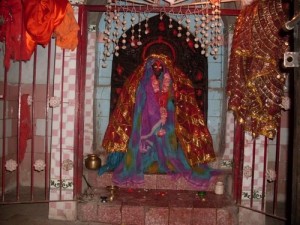 It is situated in village Mukundpur. The Mandir contains an ancient statue of Goddess Jagdamba.
It is situated in village Mukundpur. The Mandir contains an ancient statue of Goddess Jagdamba.
The Great Jama Masjid( Bhaluana ) :- It is situated at Bhaluana village.
SAHAR BLOCK
Mahamaya Mandir(Ekwari):-This temple is at Ekwari village of Sahar block. It is said that this was made during Mughal period.
Andhari :-During Archaeological Exploration done by KP Jayaswal Research Institute Early Medieval Period site have been brought to notice. Paihari Jee Ka Ashram:- It is an ashram at Dhrampur village at Sahar block.
Venkatesh Mandir(Perhap ) :- This temple situated at Perhap village. It is built as Southern architectural style.
BEHEA BLOCK
Mahathin Mai Mandir (Behiya) :-
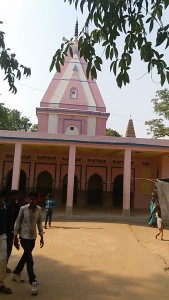 It is famous for the tomb of Mahini under a pipal tree near to the Railway station.Behiya
It is famous for the tomb of Mahini under a pipal tree near to the Railway station.Behiya 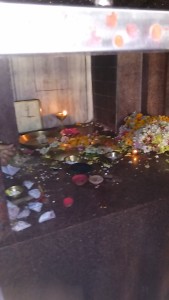 was formerly the home of a brach of Harihobans Rajputs.It is believed that the Raja Bhupat Deo violated Mahini a Brahmin women who there upon burnt herself to death and in dying imp the most fearful curses on the Harihobans Rajput. After this tragedy the clan Left Behea and across the Ganges to Ballia.
was formerly the home of a brach of Harihobans Rajputs.It is believed that the Raja Bhupat Deo violated Mahini a Brahmin women who there upon burnt herself to death and in dying imp the most fearful curses on the Harihobans Rajput. After this tragedy the clan Left Behea and across the Ganges to Ballia.
According to Jayaswal Research Institute Archaeological Explorations this site belongs to Medieval Period.
Kureshwar :- During Archaeological Exploration done by KP Jayaswal Research Institute Early Medieval Period site have been brought to notice.
JAGDISHPUR BLOCK
Jagdishpur Fort (Veer Kumar Singh Smriti Sangrahalaya) :-
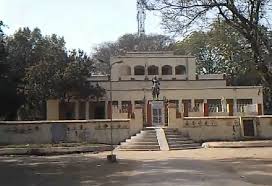 It is situated in Jagdishpur which is about 35 km from Arrah.The great warrior of 1857 Babu Veer Kunwar Singh belonged to this place. His fort is still there to reminds us of the great son of the soil who fought for the freedom till his last.In the year 1972, the Govt. of Bihar declared this paternal residence of Babu Kumar Singh as a Veer Kumar Singh Smriti Sangrahalaya.
It is situated in Jagdishpur which is about 35 km from Arrah.The great warrior of 1857 Babu Veer Kunwar Singh belonged to this place. His fort is still there to reminds us of the great son of the soil who fought for the freedom till his last.In the year 1972, the Govt. of Bihar declared this paternal residence of Babu Kumar Singh as a Veer Kumar Singh Smriti Sangrahalaya.
Mazar of Shaheed Baba :- Mazar of Shaheed Baba, a Muslim saint is situated in the compound of Jagdishpur Fort.
Dargah of Hazrat Masar Dewan(Masurhi):- The village, which is situated 5-kms east of Jagdishpur, has a 300 years old grave of a Muslim saint Masar Dewan. It is held as sacred by the Muslims.
Asudhar Siva Temple:-
Dalaur:- Located 2 km east of Jagdishpur, Dalaur is the location of the final battle which took place between Babu Kunwar Singh and the British forces in 1857
SHAHPUR BLOCK
Kurwa Shiv(BELAUTI ):- There are some ancient statues related to Banasur . It is situated in Shahpur – Bilotti Road.
According to Jayaswal Research Institute Archaeological Explorations this site belongs to Early medieval Period.
Lakar Sah Ki Mazar :- It is situated at Sahpur, it a famous mazar of a local Muslim saint.
GARHANI BLOCK
Sahi Jama Masjid(Garhani Bazzar):-This mosque built by Sher Shah is located at Garhani Bazar.
BARHARA BLOCK
Krishan Garh :-The temple of Lord Shiva is about five hundred year old. It is situated beside the river Ganga.
According to Jayaswal Research Institute Archaeological Explorations this site belongs to Early medieval period.
Maa Kali Temple( Bakhorapur) :-

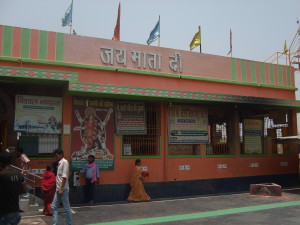 Temple is situated at the bank of holly river ganga at village Bakhorapur about 15 km from Arrah. Local say and few records show that this site existed since 1862 AD. In past, this temple was in the mid of the village near of a neem tree.The place around temple was baffled. Once a time, a disease spreaded all over the village. People thought it the affect of Devi cursed because they dreamed about it in 1948 to a local priest.He was commanded to clean the premises and establish a Kali temple there. So people placed the statue of Maa Kali with 9 Durga pindis outside the village at a genuine place.Present grown up shape of the premises came in 1999.
Temple is situated at the bank of holly river ganga at village Bakhorapur about 15 km from Arrah. Local say and few records show that this site existed since 1862 AD. In past, this temple was in the mid of the village near of a neem tree.The place around temple was baffled. Once a time, a disease spreaded all over the village. People thought it the affect of Devi cursed because they dreamed about it in 1948 to a local priest.He was commanded to clean the premises and establish a Kali temple there. So people placed the statue of Maa Kali with 9 Durga pindis outside the village at a genuine place.Present grown up shape of the premises came in 1999.
Sun Temple (Bakhorapur):-
Gundi Villege :- Village is about 11 km from Ara. It is The birthplace of World fame Great Saint, of 20th Century, Awadhoot Bhagwan Ram, Better known as Aghoreshwar Bhagwan Ram or Sarkar Baba. He was born in 1937 at Gundi village . Later he moved to Baba Keenaram Sthal,thousands year old Spiritual Centre & World Fame Headquarter of Aghor sect at Varanasi, at the age of 7 (Seven) only.
In Gundi village there is also Lord Raghunath temple in situated.This is a 75 years old temple built to Vedic Agni Kund specifications, strictly as per religious Vaastu, by the descendants of the master craftsmen who built the famous Gopuram style Meenakshipuram temple in Madurai .This Temple is built in the Puram style as prevalent in south Indian states.
According to Jayaswal Research Institute Archaeological Explorations this site belongs to Early medieval Period.
Jagatpur:- During Archaeological Exploration done by KP Jayaswal Research Institute Early Medieval Period site have been brought to notice.
KOILWAR BLOCK
Koilwar bridge :-Koilwar is situated on the River Sone, its fine lattice -girder railroad bridge called as Abdul Bari Bridge, made before 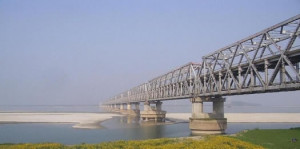 independence by British.
independence by British.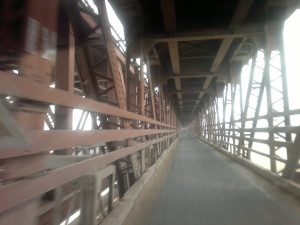
An initial survey of the bridge site was made on 17 February 1851 by George Turnbull, Chief Engineer of the East Indian Railway Company. The bridge work was started for a single line of rail in year 1855 and after many interruptions during the Mutiny, was completed in 1862. It was inaugurated by the Viceroy and governor-general of India, Lord Elgin. The second line on bridge was begun in 1868 and finished in 1870. A two lane road (NH 30) runs just under the rail tracks.
Baba Dineshwar nath Dham(Koilwar) :- It is a Temple of Lord Shiva.It is situated at the bank of river Sone at Koilwar about 16 km away from Arrah.
Goraiyasthan Balu Ghat (Koilwar):- During Archaeological Exploration done by KP Jayaswal Research Institute Medieval Period site have been brought to notice.
Jamalpur:- During Archaeological Exploration done by KP Jayaswal Research Institute Medieval Period site have been brought to notice.
SANDESH BLOCK
Shiva temple( Bartiar) :- The old Shiva temple is situated in village Bartiar under Sandesh police station, about 20 km from Arrah.
Pandura:- During Archaeological Exploration done by KP Jayaswal Research Institute Medieval Period site have been brought to notice.
Nasratpur:- During Archaeological Exploration done by KP Jayaswal Research Institute Medieval Period site have been brought to notice.
Doli Rakhawa Temple (Trikol) ( 25:25”::84;40”) :-
Deo Barunark:- It is located 99 kms from Patna. There are ruins of several temples but those dedicated to the Sun. In one of the temples are the remains of the Sanctum Sanctorum and the Assembly Hall with its ornamental pillars. The other has a stone pedestal carved with the figure of the Sun God riding His chariot, drawn by seven fully caparisoned steeds.An inscription on one of the carved pillars records the continuance of the grant of a village to the sun god by Jivita Gupta (740 AD), the last king of the Later Guptas of Magadha, who ruled before the end of the second quarter of the 8th century. Another interesting pillar of the Gupta period stands close to the temples is square and has on its four sides figures of Indra, Yama, Varuna and Kubera, the presiding deities of the east, south, west and north respectively.It is believed that the temple was built by the Sea God- Indra.
UDWANT NAGAR BLOCK
Masarha :- It is about 10 Km West of Arrah. It is an ancient village full of relies. To the east of the village there is a small river by name Banas. It is commonly believed that the village was once almost on the bank of the river Ganga that has now receded to a distance of about 10 miles. The old name of the village, as mentioned in the inscriptions in the Jain temple of Parasnath at the village, is Mahasara .
According to legend, it is the seat of Banasura or Vanaraja whose daughter Usha was married to Aniruddha, a grandson of Lord Krishna.
Hiuen Tsang visited the village and the village is identified to be Hiuen Tsang’s Mo-cho- so- la.
General Cunningham of the Archaeological Survey of India mentions that the village was originally called Padmavatipura till Vimalanatha, a Jain Kshatriya of Masarh, a village elsewhere, became the proprietor of the village and changed the name to Mahasara. Mahasara means large lake. Near the village there is a large tank commonly supposed to have extended over 52 bighas of land. The tank is now mostly silted up excepting a few patches.
There is another legend about the place-name. Some say that the previous place-name of the village was Malla Sanrh. Malla means a wrestler and Sanrh means a bull. It is said that King Banasura had built an akhara or a place for wrestling bouts where be used to practice wrestling and even wrestle with a bull. There is a mound near Karisath railway station, which is pointed out to be the place of the wrestling bouts of Banasura.
According to another legend, there were two janapadas here namely, Karusha and Malad. Karusha, the name of the railway station and the small village substitutes Karusha, and Masarha is substituted for Ma-lad.
Another legend is that Masarha is the ancient Sonitpur, the seat of Aniruddha, and the grandson of Lord Krishna. Tezpur in Assam is also claimed to be the ancient Sonitpur, the capital of Aniruddha.
All these legends, however, make out that Masar is evidently an ancient site.
The last District Gazetteer of Shahabad published in 1924 mentions that there are no Buddhist relies, but enormous images of Brahmanical goddesses were found which are still in the village. The Gazetteer mentions: “The remains at Masarh are confined to these images, the foundations of some small temples and a Jain temple completed in 1819 A.D which contains eight Jain statues on which are several inscriptions going back 1386 A.D., when some Rathor Jains of Marwar appear to have settled in the village; another figure of Parasnath contains an inscription stating that the image was dedicated by Babu Sankar Lal of Aramnagar during the prosperous English rule over Karusha- desa.
A large image identified as that of Vishnu was found at Karisath village. This eight feet high image has been removed and is now preserved at the Patna Museum.
A very remarkable and unique feature of the village is a Jain temple of Parasnath, which also accommodates Shiva Linga. The villagers think that the Jain temple was allowed to be constructed only on the condition that a Shiva lingam is enshrined within. The Jain temple is about sixty feet high and is rectangular in shape. It is located by the side of a big tank in an area of about three bighas of land. Parshwanath Tample contains eight images, some of which belong to earlier dates (1386 A.D.) as seen from the inscriptions on each of them. The temple was completed in the year 1819 A.D. There is an open platform with six round pillars about seven feet high and four feet in diameter supporting a roof.The pillars are well executed and have got some carvings near the top. The room where the deity is enshrined is rectangular and the image of Parasnath is in a sitting posture. The image is in black stone and is well- polished. It is about four feet high.There is a religious trust, known as Manilal Trust, which looks after the temple.
The Shiva temple facing east is in the same building. There is a dome on the top of the temple.
Opposite the Shiva temple there is a Devi temple. It has been recently constructed but the deity is ancient.The only door leads to the main shrine which opens into Small mandap 8’X4′, and on the same mandap on right side there is a Nandi and a small Shiva lingam. A number of images of other deities Ganesha, Saraswati and Vishnu, all very old, have also been preserved on the mandap.There are a number of other broken images of various deities. Two broken figures beautifully carved with images of Buddhist and Brahminical deities are lying uncared for.
According to Jayaswal Research Institute Archaeological Explorations this site belongs to Late NBPW period site.
Bakari:- During Archaeological Exploration done by KP Jayswal Research Institute Early Medieval Period site have been brought to notice. Bakasur Garh:- During Archaeological Exploration done by KP Jayswal Research Institute Early Medieval Period site have been brought to notice. Nawda Ben:- During Archaeological Exploration done by KP Jayswal Research Institute Early Medieval Period site have been brought to notice. Kurhawa:- During Archaeological Exploration done by KP Jayswal Research Institute Early Medieval Period site have been brought to notice. Jaitpur:- During Archaeological Exploration done by KP Jayswal Research Institute Early Medieval Period site have been brought to notice. Udwantnagar:- During Archaeological Exploration done by KP Jayswal Research Institute Early Medieval Period site have been brought to notice. Ekauna(South):- During Archaeological Exploration done by KP Jayswal Research Institute Early Medieval Period site have been brought to notice.
Surya mandir(Belaur):- It is said that it was constructed by Mauni Baba in samvat 2007.
According to Jayaswal Research Institute Archaeological Explorations this site belongs to Early Medieval Period.
